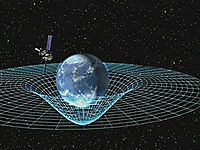
Photo from wikipedia
Conversion of vacuum fluctuations into real particles was first predicted by L. Parker considering an expanding universe, followed in S. Hawking’s work on black hole radiation. Since their experimental observation… Click to show full abstract
Conversion of vacuum fluctuations into real particles was first predicted by L. Parker considering an expanding universe, followed in S. Hawking’s work on black hole radiation. Since their experimental observation is challenging, analogue systems have gained attention in the verification of this concept. Here we propose an experimental set-up consisting of two adjacent piezoelectric semiconducting layers, one of them carrying dynamic quantum dots (DQDs), and the other being p-doped with an attached gate on top, which introduces a space-dependent layer conductivity. The propagation of surface acoustic waves (SAWs) on the latter layer is governed by a wave equation with an effective metric. In the frame of the DQDs, this space- and time-dependent metric possesses a sonic horizon for SAWs and resembles that of a two dimensional non-rotating and uncharged black hole to some extent. The non-thermal steady state of the DQD spin indicates particle creation in form of piezophonons.
Journal Title: PLoS ONE
Year Published: 2020
Link to full text (if available)
Share on Social Media: Sign Up to like & get
recommendations!